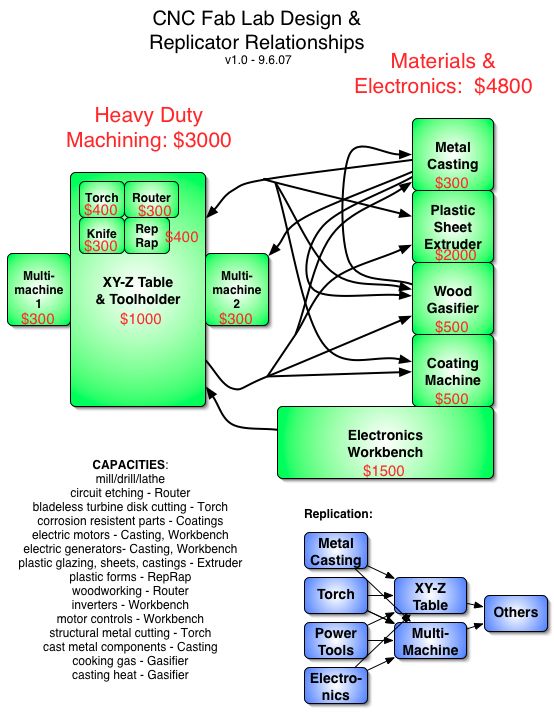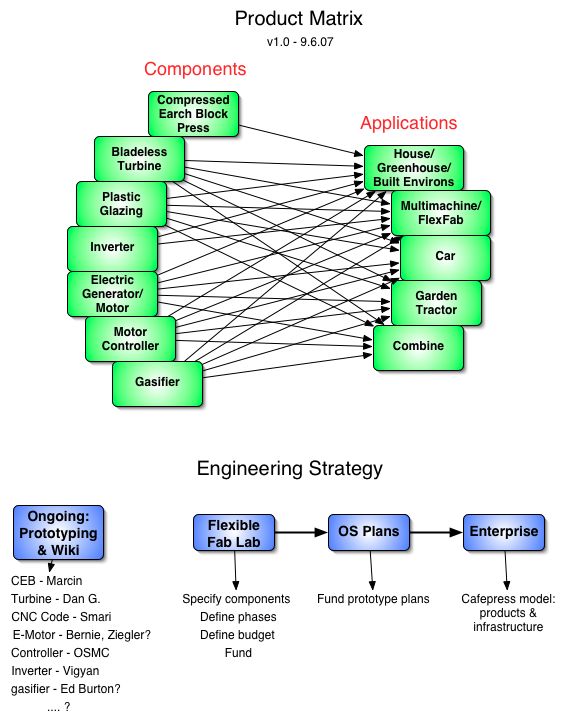GVCS Features
Jump to navigation
Jump to search

Overview
Features of the GVCS technology base, and what it enables in a community.
For an updated version, see Key Features of the GVCS.

Fab Lab design
Features
- Hybridization of power devices - decoupling of power source from the working unit in order to produce electrical drive is a formula for increasing integrated efficiency of electromechanical devices such as electric vehicles, tools, heavy equipment, etc. For example, the hybrid car decouples the engine from its wheels by using an electrical generator to feed electric wheel motors. Note that this eliminates the clutch, transmission, crank case and its oil, differential, drive train, and other parts, and replaces these items with electric wire from the generator to electric motor. This is a huge efficiency leap, one in fuel efficiency, and two, in eliminating billions of dollars of industry which is outdated today due to the hybridization option. As such, we can talk of complex machines with huge simplification, assuming easy access to infinitely scaleable and controllable, low cost electric motors (these do not exist today). For example, we can envision an agricultural combine where each moving part is powered by its own electric motor - producing a leap in simplification and maintenance of the overall machine - as all belts, pulleys, gears, and other power transmission components driven by a single engine - are all replaced by electric wire. One can point to many examples where such strategy would provide leapfrog advance in device simplicity and maintenance.
- Solar turbine power generation including heat storage - look at Solar Turbine CHP System
- Open source fab lab - combine and expand the [1] with xyz table as in RepRap (http://reprap.org/), and you can envision a robust fabrication device that integrates open source computer aided design (CAD) and computer aided manufacturing (CAM). This device would perform a large variety of machining and fabrication operations, and would be producible at the cost of materials if metal casting is available. When deployed, we are talking of producing any advanced object or device at the cost of materials. Would you like to fabricate an electric motor for your personal transport vehicle? Here, I'll email you a file to make on your local village fabber. In practice, one could conceptualize a single or several Multimachines, with their milling-drilling-lathing functions, surrounding an xyz motion platform with interchangeable heads. These heads could include acetylene torch attachment, plasma cutter, CO2 laser, router, hot wire, or additive heads such as a plastic extruder found in RepRap. This overall fab lab concept could start with a basic machine such as the Multimachine, with computer controls and table added in time. As such, this is a realistic proposition - with supporting open source knowhow with significant advancement already available. This propels civilization to new levels of decentralized material prosperity, and implies significant reduction of resource conflicts, especially if material feedstocks are sourced locally - as in the next point.
- Production of local feedstocks-
- Wood and structural masonry compressed earth block (CEB) for construction - produced from on-site trees and soils
- Compressed Fuel Gas for cooking or melting metal - gas produced from trees
- Bioplastics - such as cellophane from trees
- Biofuels - Fuel Alcohol in temperate zones, palm oil in tropical zones
- Industrial detritus (waste materials) processing - includes Metal Casting and Extrusion or Plastic Extrusion & Molding
- Aluminum Extraction From Clays
Sample Scenario
Imagine a village with buildings of dirt (CEB) with year-round greenhouses (sawmill, CEB, bioplastics from local trees), with all facility energy produced by a solar turbine, where people drive hybrid cars with car bodies (bioplastics) made from local weeds, with critical motors and metal structures (aluminum) extracted from on-site clay, which are fueled by alcohol produced on-site, on a wireless network linked to the greater world. That's just a sampling of the technology base. Food, energy, housing sufficiency. There are no poor among us - because we are all evolving human beings and farmer scientists.
See Also
| OSE Required Reading | |||
|---|---|---|---|
| Wiki instructions · Crash course on OSE · Global Village Construction Set · Getting Started Guide · Team Culturing · Version control - Genealogies | |||
